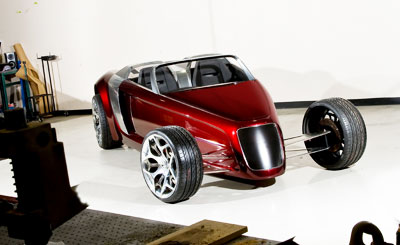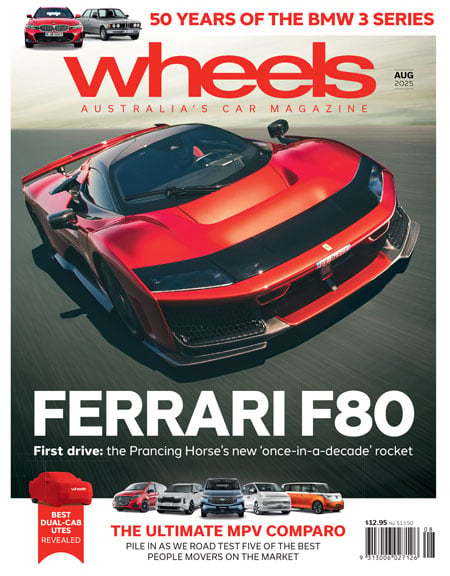This is a new-millennium custom car that was begun in the last century, yet its innovative use of cutting edge technologies and materials could change the way cars are manufactured in the not-too-distant future. It’s also one of the most ambitious hot rod projects ever undertaken, yet it was built in Melbourne, not Los Angeles.
While it may look like the work of renowned US custom-car designer Chip Foose, the exotic mid-engined FR-1 was originally conceived in the garage of Fox Classic Car Collection curator and master coachbuilder, Brian Tanti.Tanti envisaged classic hot rod lines over a high-tech, lightweight chassis powered by a large-capacity (yet fuel-efficient) engine to give it supercar performance. But he had loftier goals than just winning a gong at a hot rod show. He’s involved with a number of children’s charities, and wanted to build a unique car that could be auctioned to raise funds – hence the name Fund Raiser-1 – while also wanting to inspire school kids to consider a career within the automotive sector.“I felt we could harness the resources and skill sets of the automotive industry and do something for the community,” says Tanti, who is “unashamedly influenced” by Foose. The fact that the FR-1 bears a resemblance to the ’90s Plymouth Prowler (itself inspired by an early Foose design) is, according to Tanti, purely coincidental. While Tanti doesn’t describe himself as a hot rodder, he says he “gets the culture”.“It reminds me of the whole bespoke craftsmanship thing, what coachbuilders like Scaglietti did in the ’50s for Ferrari,” he explains.Tanti’s ability to galvanise support, both material and moral, reached all the way to the design studios of Holden, and two years ago design chief Tony Stolfo, and designers Richard Ferlazzo (of Effigy fame), Rob Walker, and former Wheels Young Designer of the Year, Harsha Ravi, enthusiastically signed on, joining long-term team members like coachbuilder Jeff Edwards, one of the backbones of the project.“Tony became very interested, initially just to help us with the interior and the beltline down, then it mutated into helping us with the exterior as well,” Tanti smiles.Working after hours, Holden’s design gurus took Tanti’s early concepts and original interior styling work done by automotive design students at Monash University (FR-1 became part of the 2003 third-year curriculum) to car-company standards using computer-aided design. Walker was responsible for the majority of the final styling.“The Holden guys were used to high-end surface development, not low-volume bespoke work … they had never worked with wooden bucks and aluminium skins,” Tanti explains.Tanti estimates Stolfo’s team has put in “the best part of $800,000 worth of R&D”. Holden also contributed the 6.0-litre V8, which features Active Fuel Management. It’s mounted behind the cockpit and mates to a Ferrari F355 transaxle.Inspired by supercars at the Fox museum like the Ferrari F40, Tanti originally planned a chromoly spaceframe chassis but interest from former HSV engineering manager Brad Dunstan, now CEO of VCAMM (the Victorian Centre for Advanced Materials Manufacturing), pushed FR-1 towards more high-tech underpinnings.That had an unexpected bonus for chief engineer, Russell Gallagher. The former FPV chassis man had been a volunteer on FR-1 and ended up working for VCAMM. It took Gallagher two years, part-time, to design the chassis using CAD. Along the way, he learned how to use MCS Finite Element Analysis software to simulate loads on suspension components.The chassis comprises four sections of carbon-composite, the smaller sections made using a new faster, cheaper, non-autoclave method of curing carbonfibre by Perth-based company, Quickstep. Another VCAMM technology, Direct Metal Deposition, or DMD, is used to create titanium mounts on the chassis for the race-inspired suspension and other components. DMD is the process of creating components by using a laser to fuse together powered metal.The biggest challenge Gallagher faced was a lack of space. “Even though the car is very long, the seating position makes the engine bay really tight,” he says. But there are clever cooling solutions such as having a radiator mounted in each air duct set into the alloy sail panel. Fans direct cool air from the ducts over the exhaust manifold and hot air is expelled via the vents in the engine cover. “The nose section is also very cramped because it tapers and we have to fit suspension arms, two monotube dampers, coil springs, an anti-roll bar, a steering column and the battery in; it’s very tight,” Gallagher adds.Looking like an insect’s endoskeleton, the chassis is a work of art in itself, which is where final designer, Jesse Diephuis, from Holden comes in. Diephuis, who had been an intern at the iconic Hot Wheels toy company after graduating in the US, calls FR-1 an “industrial custom”.“We wanted to make the car look as good without the skin on it,” Diephuis says proudly. “Because a lot of the parts will be visible, like the suspension, we really wanted to convey a cohesive design story right down to the core of the vehicle. It’s a hot rod at heart but it has the industrial technology built in to take it to the next level.” That “skin”, as Diephuis calls it, is, of course, handmade in aluminium.Eight years after Tanti built a one-third scale polystyrene model, the Tanti Coupe, as it became known, was unveiled at the Melbourne International Motor Show. Tanti hopes the finished car will be shown at the Frankfurt motor show in September, as part of a state-funded trade mission to promote innovation. After that the FR-1 will be auctioned with hopes it will raise $5m for children’s cancer charities.As for government backing, there has been limited financial input via VCAMM but Tanti says he’s keen to lobby governments for more support now that he has something tangible for them to see.“It’s been a hard sell but I don’t think it’s over,” he says, ever optimistic. “Most of the people we’ve spoken to (in government) don’t get it but when they see the car they do understand.” Prior to FR-1’s debut at the MIMS, no government minister had walked through Tanti’s door, which remains open.Body aluminium, 2 seats Drivetrain mid engine (north-south), rear drive Engine 5967cc V8, ohv, 16v Power 260kW @ 5700rpm Torque 517Nm @ 4400rpm Transmission 6-speed manual , Ferrari transaxle Size l/w/h 4100/1900/1100mm Wheelbase 3100mm Weight 1000kg Price $5,000,000 (estimated) On sale by auction, late ’09’





